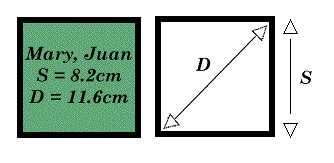Diagonal of a Square
|
Introduction
One of the very important aspects of the mathematical method in science is its ability to isolate a few essential features and analyze them independently of any context. Most equations in physics have this property. But in schools, especially in the early grades, such an isolation of features often gives the impression that mathematics is simply disconnected from the rest of the world. We present here an introduction to some important algebraic concepts that can be introduced in the early grades in a concrete setting. Activity This unit contains a mesh of topics. It includes geometry, arithmetic, and algebra, and it also calls for a variety of different skills. Therefore there is a danger that instead of showing the interaction among all these elements, it might simply create confusion. In addition each one of the five steps may contain elements that are completely new to students. Thus the unit should be spread over several class periods (possibly 5 or more), depending on the students' background and their level of competence. 1. Children work in pairs (10 to 12 pairs). Each pair cuts out a square from an index card (the squares should be of different sizes); measures its side and its diagonal in centimeters and millimeters; and writes both numbers on the square. The name of the length of the side is S, and the name of the length of the diagonal is D. They should also write their names on their square. 
Note: If the class has more than 24 students, some groups should be larger, because a table with more than 12 items can be too difficult to handle. 3. The data are sorted by the length of S, and a new table is created. This new table has an additional column, the ratio of the length of the diagonal to the length of the side of each square, rounded to two digits after the decimal point. (Children compute the ratios with calculators.)
4. Observations and remarks: 5. Conclusion written in algebraic form. When S is the length of the side of a square, and D is the length of its diagonal, then D/S = 1.415 (approximately). Or even better, D/S = C, where C is the square root of 2, which is approximately equal to 1.415. In algebra the same thing can be written in many different ways. If D/S = C, then D = C* S. Therefore we may also write our conclusion as D = C* S. Finally, in order to indicate that value of D depends on the value of S, which varies from square to square, but the value of D does not depend on the value of C, which is always the same, we write, D(S) = C*S, which is read, "D of S is equal to C times S." |